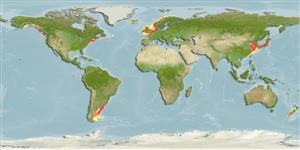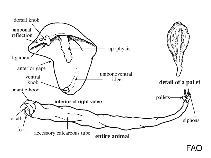Teredo navalis Linnaeus, 1758
Naval shipworm| Native range | All suitable habitat | Point map | Year 2050 |

|
| This map was computer-generated and has not yet been reviewed. |
| Teredo navalis AquaMaps Data sources: GBIF OBIS |
Google image | No image available for this species;
drawing shows typical species in Teredinidae.
Classification / Names Common names | Synonyms | CoL | ITIS | WoRMS
Bivalvia | Myida | Teredinidae
Environment: milieu / climate zone / depth range / distribution range Ecology
Benthic; brackish; depth range 0 - 150 m (Ref. 76971), usually 0 - 20 m (Ref. 75831). Temperate; 11°C - 25°C (Ref. 98650); 72°N - 58°N, 25°W - 31°E
Distribution Countries | FAO areas | Ecosystems | Occurrences | Introductions
Northeast Atlantic: Native to Iceland, Faroe and Norway. Introduced to the Baltic Sea, Mediterranean and Pacific Ocean. Temperate to tropical.
Length at first maturity / Size / Weight / Age
Maturity: Lm ? range ? - ? cm Max length : 50.0 cm TL male/unsexed; (Ref. 76971)
Short description Morphology
Life cycle and mating behavior Maturity | Reproduction | Spawning | Eggs | Fecundity | Larvae
Main reference
References | Coordinator | Collaborators
Harms, J. 1993 Check list of species (algae, invertebrates and vertebrates) found in the vicinity of the island of Helgoland (North Sea, German Bight) - a review of recent records. Helgoländer Meeresunters 47:1-34. (Ref. 2711)
IUCN Red List Status
(Ref. 130435: Version 2025-1)
CITES status (Ref. 108899)
CMS (Ref. 116361)
Threat to humans
Human uses
Fisheries: of no interest
| FishSource |
Tools
More information
Diet composition
Food consumption
Predators
Max. ages / sizes
Length-weight rel.
Length-length rel.
Length-frequencies
Mass conversion
Abundance
Internet sources
BHL | BOLD Systems | CISTI | DiscoverLife | FAO(Publication : search) | Fishipedia | GenBank (genome, nucleotide) | GloBI | Gomexsi | Google Books | Google Scholar | Google | PubMed | Tree of Life | Wikipedia (Go, Search) | Zoological Record



